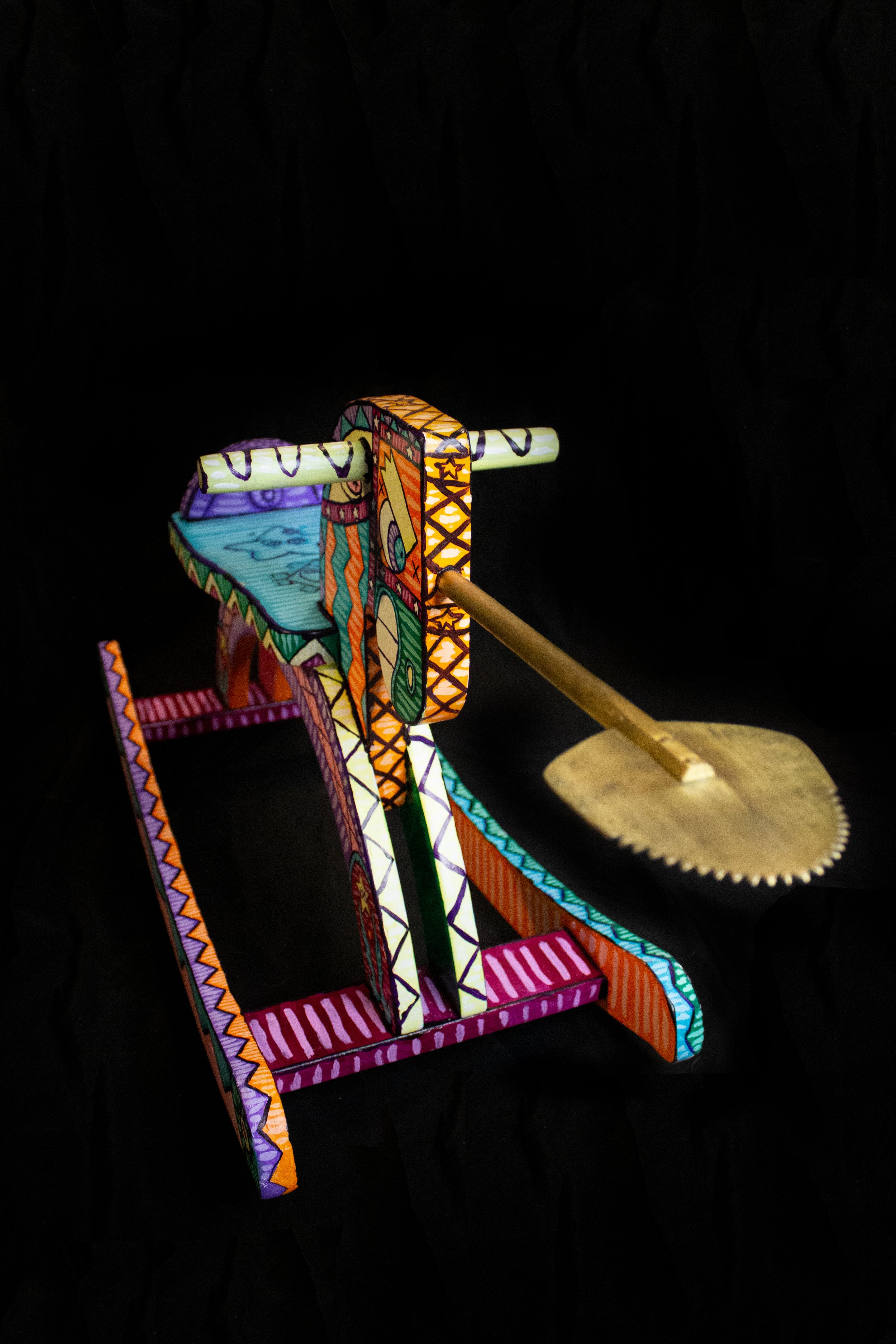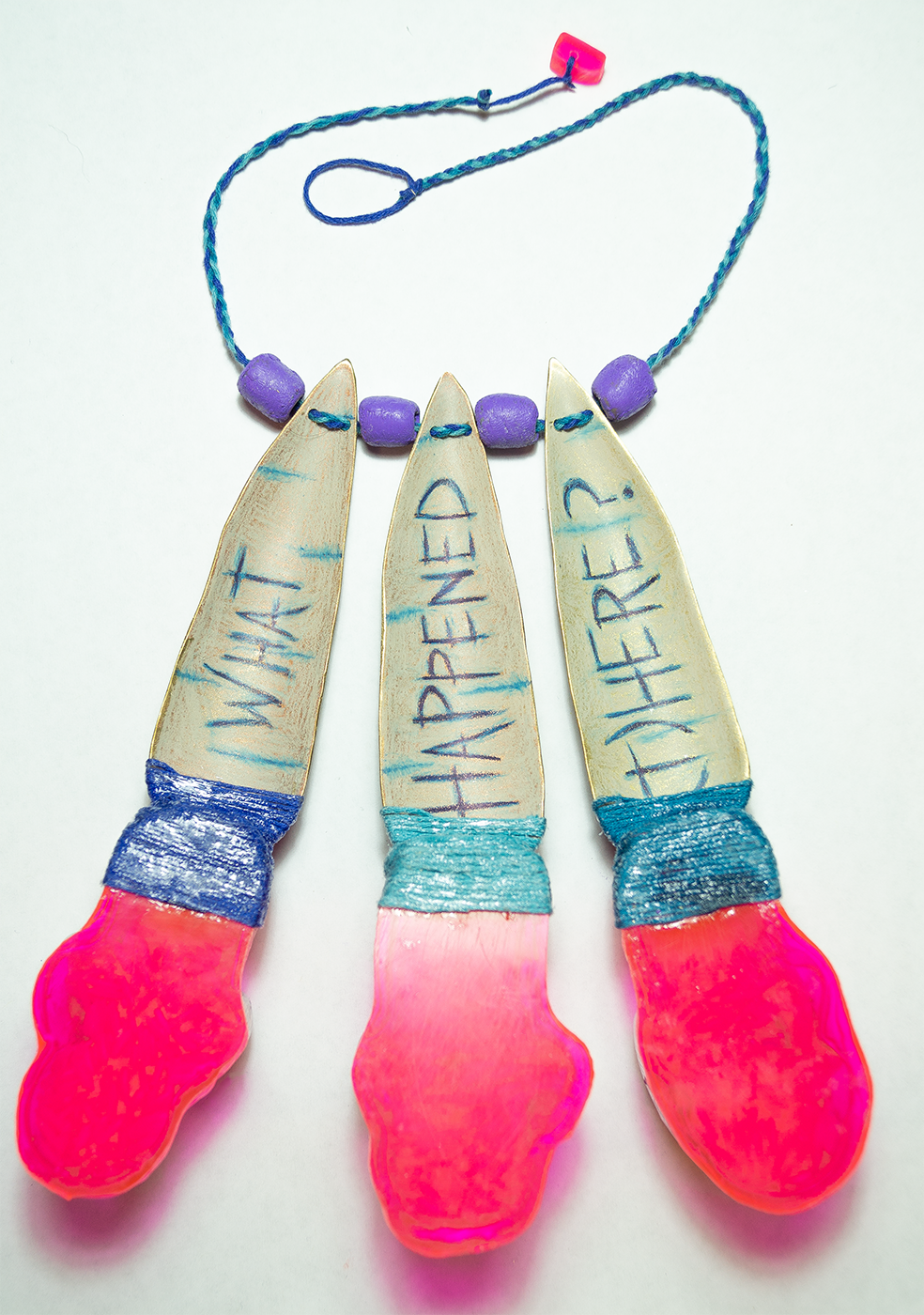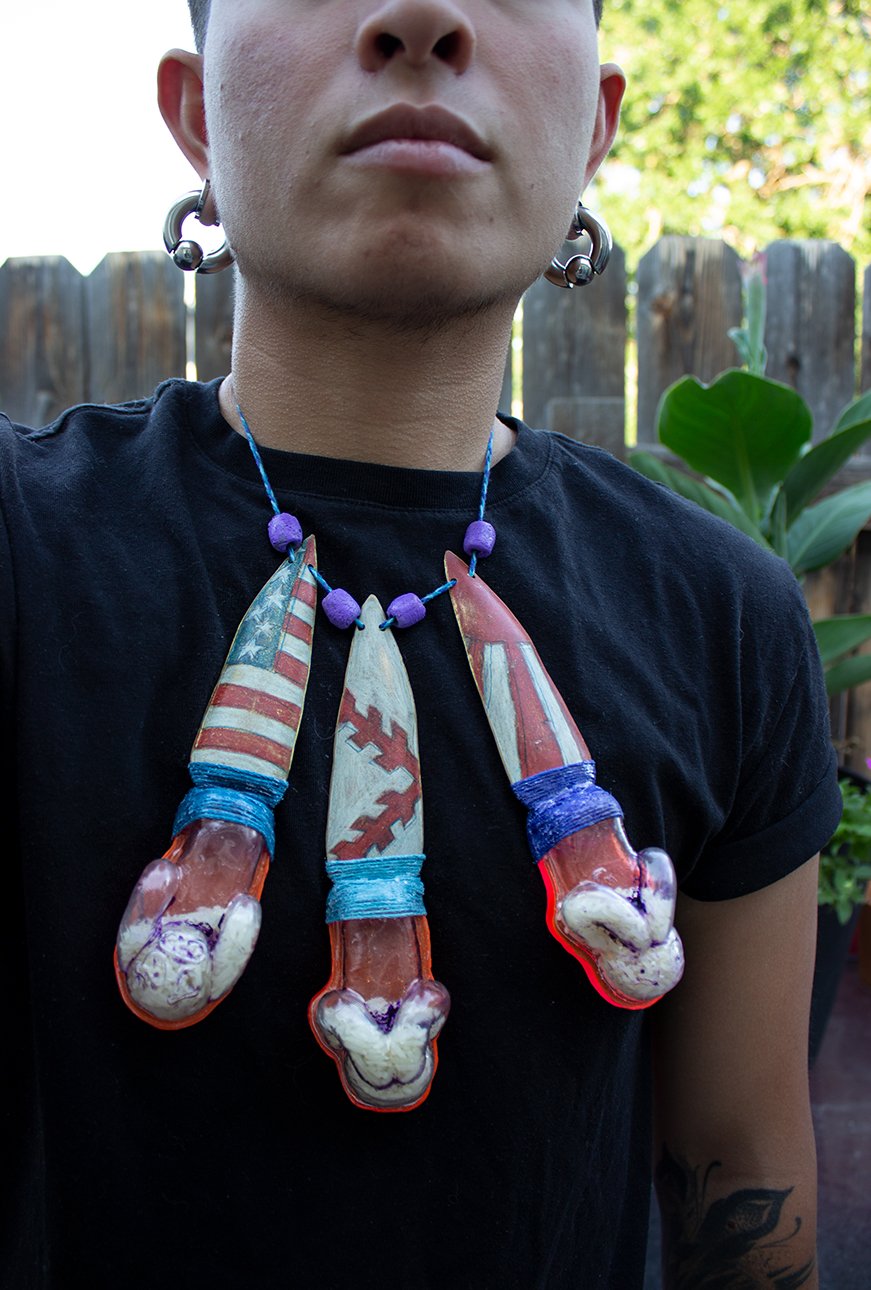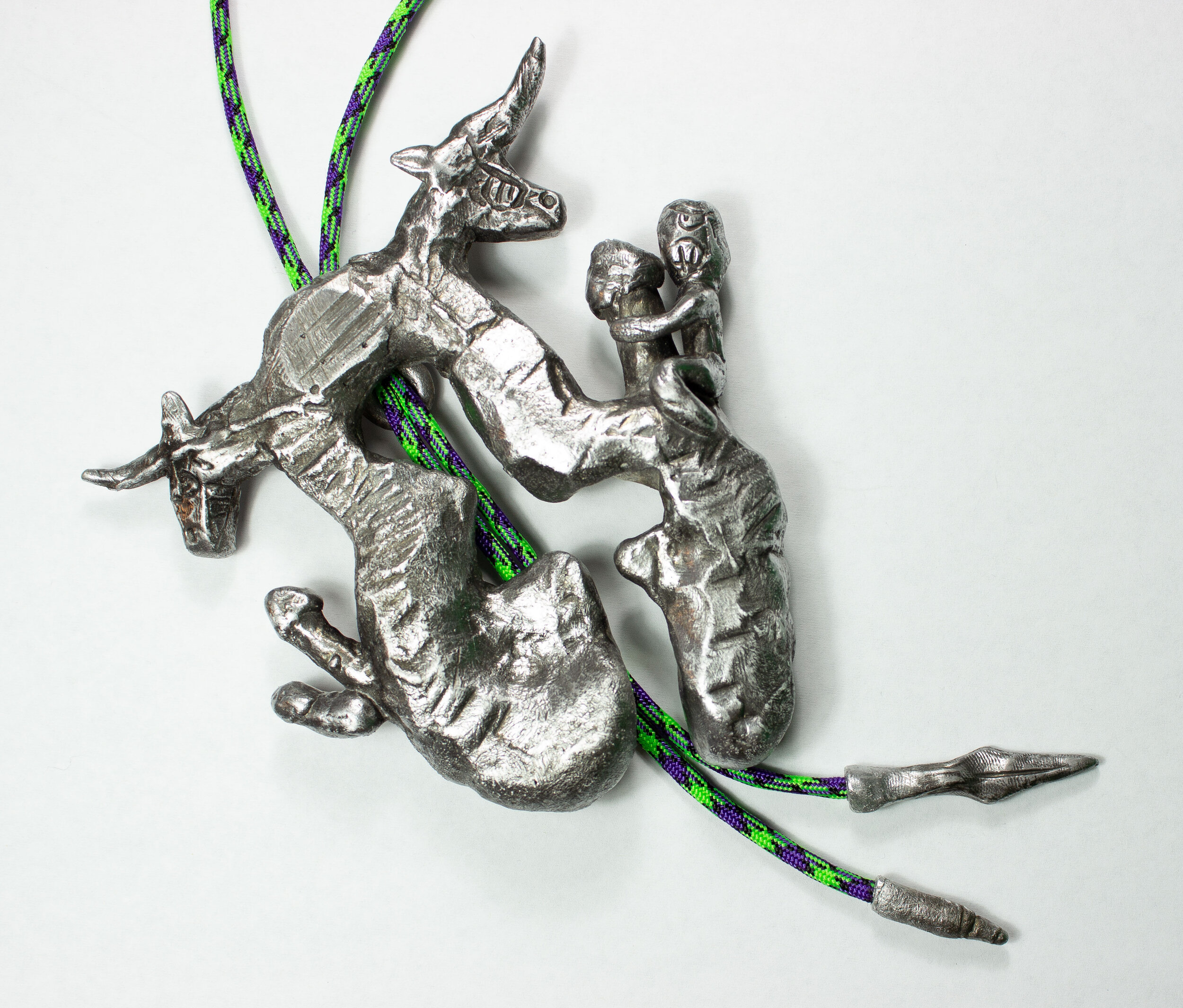Jewelry & Objects








Kudkuran Ng Niyog
2022
Coconut grater mounted on rocking horse.
Wood, Acrylic Paint, Brass
3.5ft L X 2.5 ft H X 2 ft W
This piece represents my Filipino heritage through a coconut grater I crafted from brass, attached to a rocking horse. Inspired by traditional coconut graters used in the Philippines, this object transcends its utilitarian purpose, becoming both a tool and a toy. Adorned with patterns influenced by the Visayan region, it blends tradition with playful reimagining.
Traditional Filipino coconut graters are often wooden stool-like structures, where the user sits for support while grating. These graters are sometimes referred to as "horses" due to their shape, and some are even designed to resemble animals. In my reimagined version, the rocking horse is brightly colored with patterns rooted in Filipino culture. Two contrasting facial expressions on either side—one reflecting fear, the other frustration—along with the brass grater protruding from its head, embody my own experience of hybridity. As a Filipino-American, I often grapple with the tension between my White and Filipino identities, facing moments of confusion and frustration as I navigate the complexities of authenticity. This object becomes a metaphor for my ongoing exploration of selfhood, representing the struggle to reconcile my cultural heritage, which is neither fully Filipino nor fully American.
The rocking horse offers me a playful space to experiment with and express my identity, creating an opportunity to define my own cultural experience, free from the constraints of rigid classification.



What Happened (T)Here? (Boaya)
2021
necklace
Vacuum formed brass and plastic colored pencil, cotton string, rice, polymer clay, and acrylic paint
12” X 9” inches
Narratives of history and colonization are experienced differently across the globe, often creating a profound sense of dissonance and disconnection. As a Filipino-American who grew up in both the Philippines and the United States, I have encountered this firsthand. This work seeks to explore these feelings as I grapple with a heritage that, at times, feels distant and elusive.
In the Philippines, I was taught from an early age about the impact of war on the Islands—how my ancestors fought and sacrificed for centuries to free the Philippines from the violent and exploitative forces of imperialism. Yet, these lessons often overlooked the lives and cultures of the Islanders before colonization. In contrast, when I moved to the United States, it wasn’t until I began college that I even encountered a mention of Philippine history—usually in the form of oversimplified and misrepresented accounts of the Spanish, American, and Japanese wars.
This disconnection created a void within me, a sense of uncertainty about the past—about what happened to my ancestors, what it means to be Filipino-American, and what the future holds for Filipinos in the diaspora. This work is an exploration of that void, delving into the complexities of identity, history, and the ongoing search for understanding a heritage that feels both fragmented and distant.
The necklace I have created reflects my experience of being “neither here nor there,” caught between two cultures and histories. It incorporates elements of war and conflict—both Western and Eastern—symbolizing the internal and external battles faced not only by myself but by many Filipinos. Drawing from the traditional Filipino boaya jewelry worn by headhunting warriors, I have reimagined it with elements of colonization: the flags of the countries that colonized the Philippines replace the traditional teeth ornamentation.
In my version, the teeth, which are typically displayed hanging downward on the boaya, are flipped upside down, their sharp ends pointed threateningly toward the neck. The three humanoid figures, the Anitos—representing ancestors—also hang upside down, echoing the "see no evil, speak no evil, hear no evil" motif. This imagery reflects my frustration with the general lack of knowledge about our history and how this absence can impact current and future generations. The question I ask is: What happened there? What happened in the Islands that are now so far away, separated by time and distance? And, What happened here? How does this distant past continue to affect me today?
Despite the grim history of war and colonization, I anchor my work in a sense of pride for my heritage and a deep curiosity for the past. I believe that through understanding history and its effects on my identity, we can move toward a more harmonious future, one that honors the complexities of our collective experiences.



Bolo Lingling-O
2021
Necklace
Casted aluminum and paracord bolo
12” X 6” inches
The Bolo Lingling-O encapsulates the complex experience of being a Filipino-American. It is a hybrid object, merging the traditional lingling-o with the bolo tie, blending elements of both Western and Eastern cultures, masculinity and femininity, as well as ancient and modern influences. This piece symbolizes conflict—its form is raw, distorted, and its components at odds with one another.
The lingling-o is a traditional Filipino amulet, historically worn as earrings or pendants, especially by the Igorots. These amulets were given as gifts to newlyweds, used for fertility, good luck, protection from ancestral spirits (Anitos), and as symbols of class and power. Today, they continue to hold significance as a symbol of heritage pride. Traditionally, they are symmetrical, smooth, and polished. In warping this symbol, I reflect my personal experience of being distanced from my heritage and the struggle to understand my roots in the face of language barriers and living in America.
The humanoid figure within the piece represents the Anitos—guardians of Filipino culture and spirit. Here, they are depicted as frightened by looming longhorn bulls, representing Western colonization and the way it has historically threatened and overshadowed much of the Philippines’ pre-colonial history. Inside the lingling-o, what should represent the feminine is shriveled and distorted, while the outside, typically strong and masculine, overpowers with the presence of two phalluses, disrupting the balance of nature and community.
The pendant is heavy on the chest, symbolizing the weight of these contradictions. The neon green and purple paracord—a modern material—clashes with the traditional, highlighting the tension between cultural heritage and contemporary life. The tassel ends are fashioned as a bullet and spearhead, referencing the long history of conflict—both internal and external—that continues to shape my identity as a Filipino in the diaspora. This piece is a physical manifestation of the struggles, complexities, and tensions that accompany being caught between two cultures, and it speaks to the ongoing battle for cultural understanding and personal reconciliation.
Babayin Initials
2020
Pin
Copper and enamel
1” X 0.5” inches
This pin has my initials in Babayin, a script of the Philippines before the introduction of the Latin alphabet during the Spanish colonialization.
Wiggly person
2020
Pin
Brass and resin
1” X 0.5” inches


HOLDING THE SEED
2019
Ring
Silver
2” X 2” inches
The onyx stone sitting in the middle of the ring is representative of a seed, where two hands are caressing and protecting it. The preservation of the seed is what will give it the chance to grow once it can be planted. The seed represents a relationship, be that with a romantic partner, friend, family, and the self. We must support it with love and care in order for it to bloom.


Visayan Cuff
2019
Cuff
Copper
3” X 3” inches
Visayas is a region of the Philippines where my mother's family is from. In this region there were popular design patters that were used in textiles and tattoos. Two deigns are present on here, that of the flower, which represents the traveler, and the teeth, which represent the crocodile granting the wearer strength.

